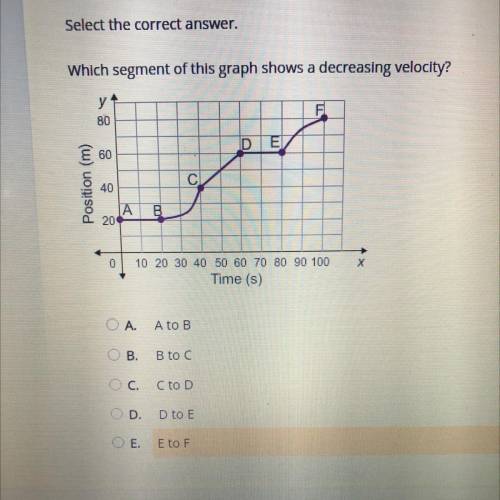Which segment of this graph shows a decreasing velocity?
A. A to B
B. B to C
C. C to D<...

Physics, 18.11.2020 17:50 foralways3178
Which segment of this graph shows a decreasing velocity?
A. A to B
B. B to C
C. C to D
D. D to E
E. E to F


Answers: 2


Other questions on the subject: Physics

Physics, 21.06.2019 14:30, tjgamer12
Is the alien theory a scientific claim? why or why not? just took the test it was , : " the alien theory is not a scientific claim because it is not based on valid data, there is no evidence to support it, and it does not come from a reliable source."
Answers: 3

Physics, 22.06.2019 06:40, miaglory3828
Light traveling in a medium with a refractive index 1.19 is incident on a plate of another medium with index of refraction 1.79. at what angle of incidence is the reflected light fully polarized?
Answers: 2

Physics, 23.06.2019 03:20, marshaehayes9444
Neutrons are placed in a magnetic field with magnitude 2.30 t. part a part complete what is the energy difference between the states with the nuclear spin angular momentum components parallel and antiparallel to the field? δe δ e = 2.77×10−7 ev previous answers correct part b part complete which state is lower in energy: the one with its spin component parallel to the field or the one with its spin component antiparallel to the field? which state is lower in energy: the one with its spin component parallel to the field or the one with its spin component antiparallel to the field? parallel antiparallel previous answers correct part c part complete how do your results compare with the energy states for a proton in the same field (δe=4.05×10−7ev)? how do your results compare with the energy states for a proton in the same field this result is smaller than but comparable to that found in the example for protons. this result is greater than but comparable to that found in the example for protons. previous answers correct part d the neutrons can make transitions from one of these states to the other by emitting or absorbing a photon with energy equal to the energy difference of the two states. find the frequency of such a photon. f f = mhz previous answersrequest answer incorrect; try again; 5 attempts remaining
Answers: 2
You know the right answer?
Questions in other subjects:

Mathematics, 26.09.2021 01:50

English, 26.09.2021 01:50

History, 26.09.2021 01:50


Mathematics, 26.09.2021 01:50


Biology, 26.09.2021 01:50


Spanish, 26.09.2021 01:50

Mathematics, 26.09.2021 01:50



